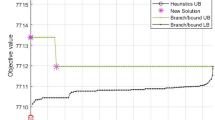Abstract
In this paper, a novel multi-phase mathematical approach is presented for the design of a complex supply chain network. From the point of network design, customer demands, and for maximum overall utility, the important issues are to find suitable and quality companies, and to decide upon an appropriate production/distribution strategy. The proposed approach is based on the genetic algorithm (GA), the analytical hierarchy process (AHP), and the multi-attribute utility theory (MAUT) to satisfy simultaneously the preferences of the suppliers and the customers at each level in the network. A case study with a good quality solution is provided to confirm the efficiency and effectiveness of the proposed approach. Finally, to demonstrate the performance of the proposed approach, a comparative numerical experiment is performed by using the proposed approach and the common single-phase genetic algorithm (SGA). Empirical analysis results demonstrate that the proposed approach can outperform the SGA in partner selection and production/distribution planning for network design.








Similar content being viewed by others
References
Meade L, Liles D and Sarkis J (1997). Justifying strategic alliances and partnering: a prerequisite for virtual enterprising. Omega—Int JMngt Sci 25: 29–42.
Jagdev H and Browne J (1998). The extended enterprise—a context for manufacturing. Prod Plan Control 9: 216–229.
Talluri S, Baker R and Sarkis J (1999). A framework for designing efficient value chain networks. Int J Prod Econ 62: 133–144.
Papazoglou M, Ribbers P and Tsalgatidou A (2000). Integrated value chains and their applications from a business and technology standpoint. Decis Support Syst 29: 323–342.
Mikhailov L (2002). Fuzzy analytical approach to partnership selection in formation of virtual enterprises. Omega—Int J Mngt Sci 30: 393–401.
Sha DY and Che ZH (2005). Virtual integration with a multi-criteria partner selection model for the multi-echelon manufacturing system. Int J Adv Manuf Tech 25: 793–802).
Korhonen P, Huttunen K and Eloranta E (1998). Demand chain management in global enterprise–information management view. Prod Plan Control 9: 526–531.
Davis M and O’Sullivan D (1999). Systems design framework for the extended enterprise. Prod Plan Control 10: 3–18.
Talluri S and Baker R (1996). Quantitative framework for designing efficient business process alliances. Proceedings of 1996 International Conference on Engineering and Technology Management Piscataway, pp 656–661.
Weber CA and Desai A (1996). Determination of paths to vendor market efficiency using parallel coordinates representation: a negotiation tool for buyers. Eur J Opl Res 90: 142–155.
Wang D, Ip WH and Yung KL (2001). A heuristic genetic algorithm for subcontractor selection in a global manufacturing environment. IEEE Trans Syst Man Cybern C 31: 189–198.
Muralidharan C, Anatharaman N and Deshmukh SG (2002). A multi-criteria group decision making model for supplier rating. J Supply Chain Mngt 3: 22–33.
Gen M and Cheng R (1997). Genetic Algorithms and Engineering Design. Wiley: New York.
Holland JH (1975). Adaptation in Natural and Artificial Systems. University of Michigan Press: Ann Arbor.
Saaty TL (1980). The Analytic Hierarchy Process. McGraw-Hill: New York.
Saaty TL (1983). Priority setting in complex problems. IEEE Trans Eng Mngt 30: 140–155.
Dyer RF and Forman EH (1992). Group decision support with the analytic hierarchy process. Decis Support Syst 8: 99–124.
Korpela J, Lehmusvaara A and Tuominen M (1999). An integrated approach for truck carrier selection. Int J Logistic 2: 5–20.
Al-Harbi KMAS (2001). Application of the AHP in project management. Int J Proj Mngt 19: 19–27.
Lai VS, Wong BK and Cheung W (2002). Group decision making in a multiple criteria environment: a case using the AHP in software selection. Eur J Opl Res 187: 134–144.
Muralidhar K, Santhanam R and Wilson RL (1990). Using the analytic hierarchy process for information system project selection. Inform Mngt 18: 87–95.
Keeney RL and Raiffa H (1976). Decisions with Multiple Objectives: Preferences and Value Tradeoffs. Wiley: New York.
Suslick SB and Furtado R (2001). Quantifying the value of technological, environmental and financial gain in decision models for offshore oil exploration. J Petrol Sci Eng 32: 115–125.
Walls MR (1995). Corporate risk tolerance and capital allocation: a practical approach to implementing an exploration risk policy. J Petrol Tech 47: 307–311.
Walls MR and Dyer JS (1996). Risk propensity and firm performance: a study of the petroleum exploration industry. Mngt Sci 42: 1004–1021.
Kumar J and Sheblé G (1997). A decision analysis approach to the transaction selection problem in a competitive electric market. Electr Pow Syst Res 38: 209–216.
Nepomuceno F, Suslick SB and Walls MR (1999). Investment and technology decision model in offshore oil exploration in Brazil: a decision analysis using multi-attribute utility theory. Nat Resour Res, JIntMath Geol 8: 193–203.
Author information
Authors and Affiliations
Corresponding author
Rights and permissions
About this article
Cite this article
Sha, D., Che, Z. Supply chain network design: partner selection and production/distribution planning using a systematic model. J Oper Res Soc 57, 52–62 (2006). https://doi.org/10.1057/palgrave.jors.2601949
Received:
Accepted:
Published:
Issue Date:
DOI: https://doi.org/10.1057/palgrave.jors.2601949




